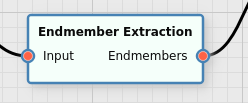Endmember Extraction Filter
Extracts endmembers from an input training data set.
Category |
|
Node |
|
Parameters |
Composition: which algorithm is used to determine the endmembers:
Determination: the starting conditions for the endmember extraction algorithm (only relevant if Composition is not Group Average):
Endmembers: the number of endmembers to extract in the Pure Pixel case. If Determination is Group Supervised this gives the number of endmembers per group. Iterations (only relevant in the Mixed Pixel case): the maximum number of iterations to perform the extraction algorithm for Refinement (only relevant in the Pure Pixel case): whether to perform an additional refinement step on the endmembers found Applicable (per group): whether a group is applicable to this filter, only relevant for the Group Average and Group Supervised cases. |
Inputs |
Input: the input data |
Outputs |
Endmembers: the endmembers that were determined from the input data (This is training only data that will only be used indirectly during execution) |
Effect of the Filter
The filter is generally used in combination with the Abundance Determination Filter. It calculates endmembers, i.e. spectra that are representative for the entire training data set. Endmembers are generally chosen so that they can be used to span a simplex encompassing the training data. Each spectrum within the training data may then be represented as a combination of the endmembers.
The output of the filter consists of training-only data. Its only purpose is to be input to other trained filter, such as the aforementioned Abundance Determination Filter.
